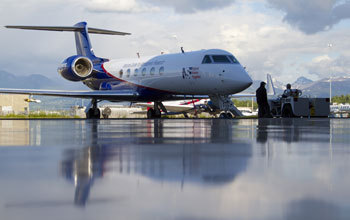The NSF/NCAR Gulfstream V aircraft in Anchorage, Alaska, as it takes part in the HIPPO study. Image:
The NSF/NCAR Gulfstream V aircraft in Anchorage, Alaska, as it takes part in the HIPPO study. Image: UCARSeasonal carbon dioxide range expanding as more is added to Earth’s atmosphereLevels of carbon dioxide in the atmosphere rise and fall each year as plants, through photosynthesis and respiration, take up the gas in spring and summer, and release it in fall and winter.Now the range of that cycle is expanding as more carbon dioxide is emitted from burning fossil fuels and other human activities, according to a study led by scientists at the Scripps Institution of Oceanography (SIO).The findings come from a multi-year airborne survey of atmospheric chemistry called HIAPER Pole-to-Pole Observations, or HIPPO.Results of the study are reported in a paper published online this week by the journal Science.The National Science Foundation (NSF), along with the U.S. Department of Energy, the National Center for Atmospheric Research (NCAR), the National Oceanic and Atmospheric Administration (NOAA) and the Office of Naval Research funded the study.“This research provides dramatic evidence of the significant influence the land-based biosphere can have on the amplitude [amount of change] in seasonal trends of carbon dioxide exchange,” says Sylvia Edgerton, program director in NSF’s Division of Atmospheric and Geospace Sciences, which funded the research.Observations of atmospheric carbon dioxide made by aircraft at altitudes between 3 and 6 kilometers (10,000-20,000 feet) show that seasonal carbon dioxide variations have substantially changed during the last 50 years.The amplitude increased by roughly 50 percent across high latitude regions north of 45° N, compared with previous aircraft observations from the late 1950s and early 1960s.This means that more carbon is accumulating in forests and other vegetation and soils in the Northern Hemisphere during the summer, and more carbon is being released in the fall and winter, says study lead scientist Heather Graven of SIO.It’s not yet understood, she says, why the increase in seasonal amplitude of carbon dioxide concentration is so large, but it’s a clear signal of widespread changes in northern ecosystems.Continue readingFurther reading:Catastrophic climatic events leave corals facing a decade-long fight for recoveryGreenhouse gas likely altering ocean foodchainScientists Explore New Technologies That Remove Atmospheric Carbon Dioxide -- source link
Tumblr Blog : probablyasocialecologist.tumblr.com
#environment#climate change#carbon dioxide
